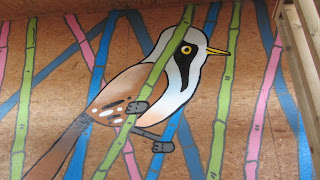About 2pm om Monday I heard of Penduline Tit nr Lowestoft, but with rain still hammering down I waited. I had already got soaked shopping in Cromer and I failed to see the 2 Black Redstart by the Pier. By 3pm I had decided with the rain easing to go and walk the patch at Paston Cliffs. The Penduline Tit I would look for on Tuesday and head onward to Minsmere RSPB afterwards.
The patch was as expected, quiet with drizzle still heavy in the air. I found no migrants but the small flock of Yellowhammer seen last week now numbers 30+, a large group of Corvids (300+) mainly Carrion Crow were on the plough by the Gas Terminal and 2 Stock Dove were nearby. Walking west I hoped for a Wheatear by the Paddocks but could only turn up a lone Meadow Pipit, a finch flock and handful of Starling. After conducting an emergency stop near Knapton, with the window down I heard a singing Blackcap, and saw the bird just yards from were I had pulled up. Typically the rain finally stopped for the day as i pulled back into the yard at home.
Tuesday (3rd) was my set aside bird watching day of a few days off work, so after dropping off Agnes I headed for the Penduline Tit site near Lowestoft. I soon found the site and had to walk only a short distance before finding a gathering of people. After waiting 20 minute there was no sign but birders present had seen it earlier so i wasnt worried, I did walk the short distance to the railway bridge and scan Lake Lothing (Lowestoft's Inner Harbour) and soon located the Shag and Common Scoter present. Back at the Penduline Tit there and been movement seen deep in the rushes, and although initially I saw a Chiffchaff I eventually saw the Penduline Tit. The bird then flew into the willows giving great views is to silhouetted for a photo. The bird showed well on and off for the next 20 minutes, but sadly most of my attempts at photography were poor, but I was more than satisfied with the great views of the bird.

I arrived at Minsmere in good time, and after having my wallet emptied to enter, checked the sightings board and headed off to add a few birds to the year lift. At North Hide I spent quite awhile locating one of 2 Jack Snipe present, while seeing lots of commoner species. I heard Bearded Tit pinging while walking to the beach but failed to see any. Looking out to see a few gulls drifted past and 2 Red-throated Diver headed North. From the East Hide 2 Sandwich Tern were found while of was there and are probably new arrivals and a guide pointed out the sleeping female Goosander that has been present most of the winter. Mediterranean Gull number must have been 30+ and along with Black-headed Gull they dominated the scrape. A quick poke around the infamous 'Sluice Bushes' soon turned up one of the reported 3 Firecrest present, before a waded along the flooded path to the South Hide. I spent awhile looking for the 2 redhead Smew reported the evening before, but after scanning lots of sleeping Teal decided they must have moved on. Up to 3 Sandwich Tern could be seen and may have been in addition to the birds seen earlier, a drake Pintail the only other highlight apart from more immaculate Mediterranean Gull. The West hide offered little new as it over looks the same scrape as North Hide, although it does have some lovely graffiti style artwork, and 2 Bearded Tit flew through. Bittern Hide was very busy, much like most of the hides and with little to see and no seating I wandered down to Island Mere. The hide was empty and I got point blank views of Little Egret in front of the hide and up to 6 Marsh Harrier displayed over the reeds. A Little Gull was also present. Back at the Visitor Center I grabbed a rather nice Date Slice and cuppa, and admiring the Marsh Tit on the feeder before heading off.

I left the reserve via the Eastbridge exit keen to see the Glossy Ibis of the flood there and maybe go onto Aldburgh to look for an illusive Night Heron. I soon found the 'flood' but it covered the road to knee height (a walker waded it), I couldn't see the Ibis so turned around. Aldburgh is quite a detour so I decided to pop to Dunwich Heath for Dartford Warbler. As I arrived hour a squally shower passed through, and reluctant to pay the National Trusts £5 parking for a short walk, conducted a slow drive by bird watch without success before heading home. Undecided on the best route home I pulled over at Wangford to check the map, and spotted a raptor being harassed by some crows. It turned out to the the escaped Black Kite that frequents the area, a nice bird if untickable.














